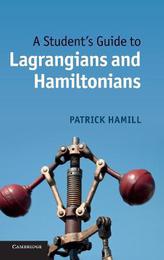
|
A Student's Guide to Lagrangians and Hamiltonians
Hardback
Main Details
| Title |
A Student's Guide to Lagrangians and Hamiltonians
|
| Authors and Contributors |
By (author) Patrick Hamill
|
| Series | Student's Guides |
|---|
| Physical Properties |
| Format:Hardback | | Pages:184 | | Dimensions(mm): Height 229,Width 152 |
|
| Category/Genre | Classical mechanics |
|---|
| ISBN/Barcode |
9781107042889
|
| Classifications | Dewey:531 |
|---|
| Audience | | Tertiary Education (US: College) | | Professional & Vocational | |
|---|
| Illustrations |
Worked examples or Exercises; 26 Line drawings, unspecified
|
|
Publishing Details |
| Publisher |
Cambridge University Press
|
| Imprint |
Cambridge University Press
|
| Publication Date |
21 November 2013 |
| Publication Country |
United Kingdom
|
Description
A concise but rigorous treatment of variational techniques, focussing primarily on Lagrangian and Hamiltonian systems, this book is ideal for physics, engineering and mathematics students. The book begins by applying Lagrange's equations to a number of mechanical systems. It introduces the concepts of generalized coordinates and generalized momentum. Following this the book turns to the calculus of variations to derive the Euler-Lagrange equations. It introduces Hamilton's principle and uses this throughout the book to derive further results. The Hamiltonian, Hamilton's equations, canonical transformations, Poisson brackets and Hamilton-Jacobi theory are considered next. The book concludes by discussing continuous Lagrangians and Hamiltonians and how they are related to field theory. Written in clear, simple language and featuring numerous worked examples and exercises to help students master the material, this book is a valuable supplement to courses in mechanics.
Author Biography
Patrick Hamill is Professor Emeritus of Physics at San Jose State University. He has taught physics for over thirty years and his research interests are in celestial mechanics and atmospheric physics.
Reviews'... in a logically clear and physically rigorous way the book highlights the landmarks of the analytical mechanics so that the attentive student can be easily prepared for the exam. It is suitable for studying in intermediate and upper-level undergraduate courses of classical mechanics ...' Vladimir I. Pulov, Journal of Geometry and Symmetry in Physics
|